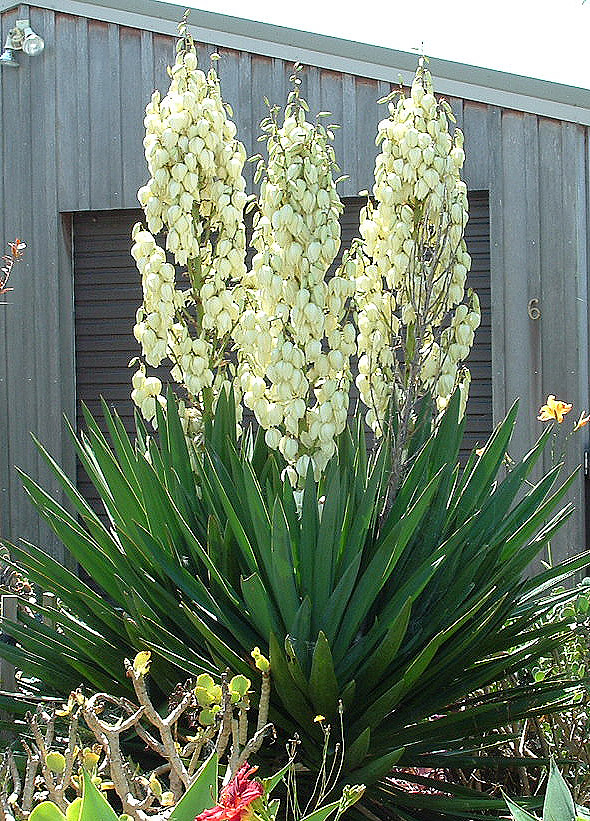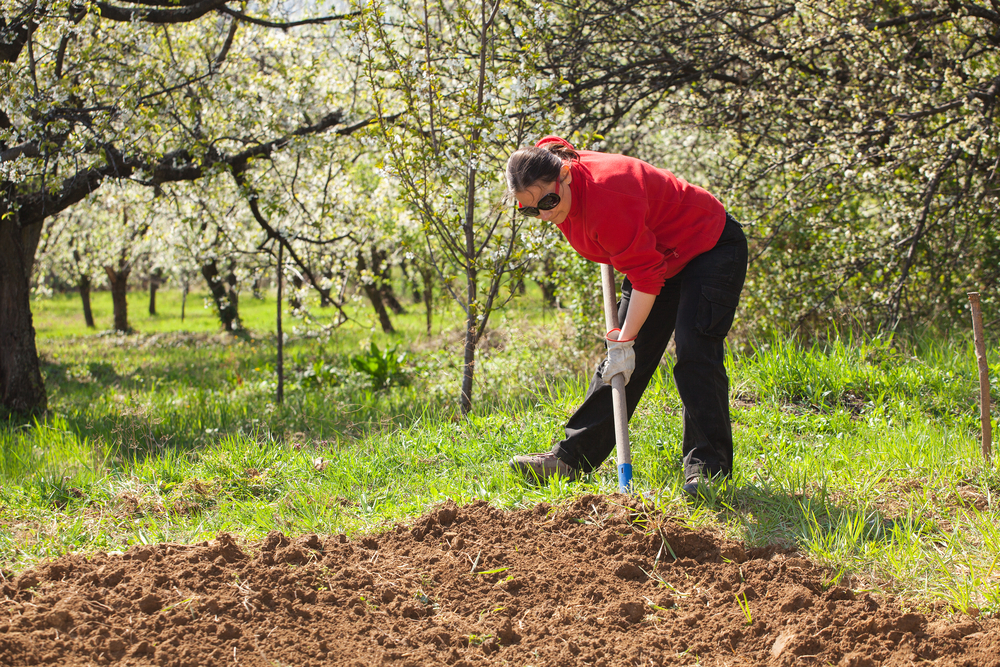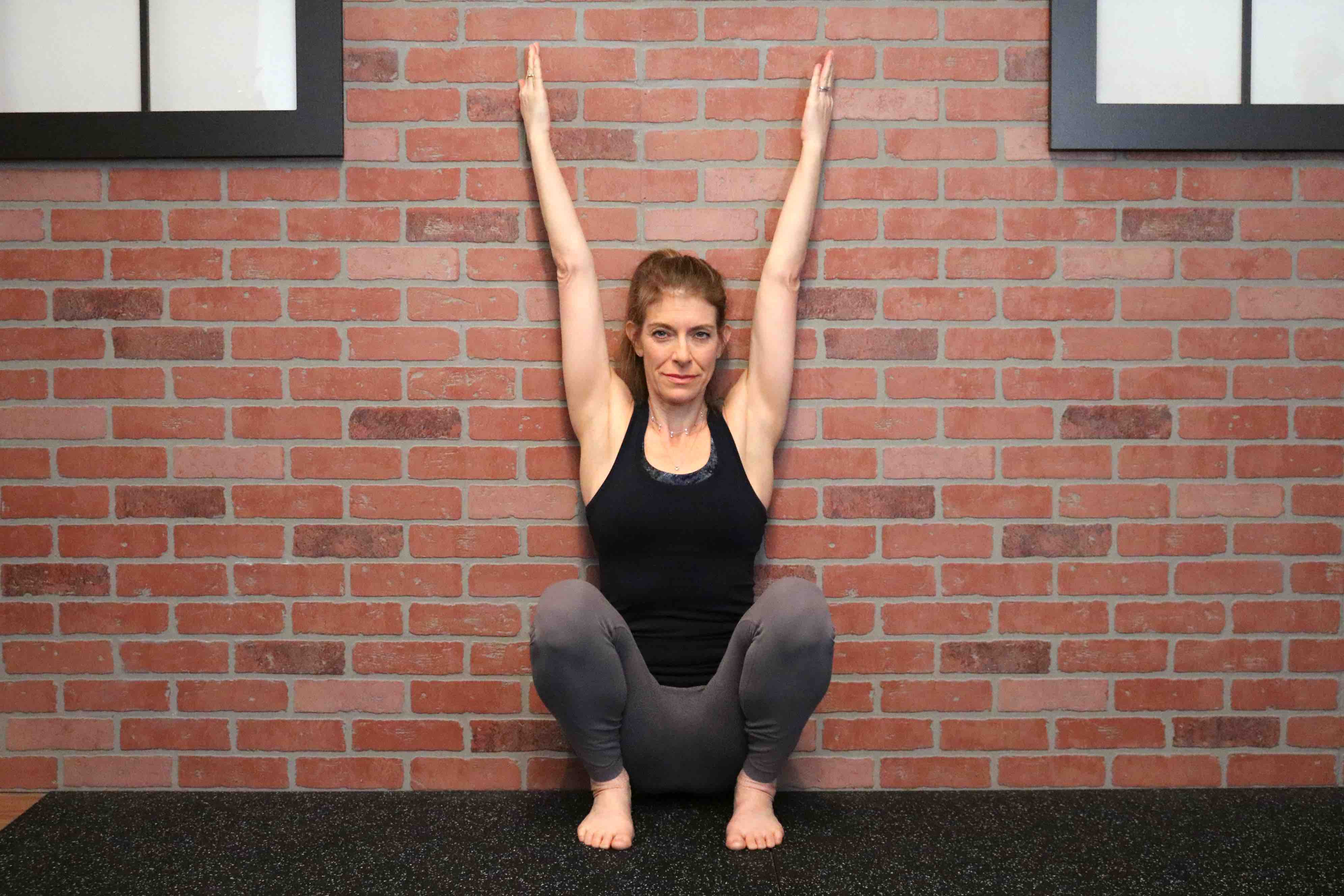
If you’re a gardener, the appearance of the first spring blossoms can feel like Christmas Eve feels to a five-year-old. I’ve never ceased being amazed when the tiny, inert seeds I tuck into the ground produce radishes, fresh peas and fragrant flowers for the table. I’m always startled by how quickly time passes when I’m digging weeds or pruning shrubs.
Gardening is great functional fitness, while also being meditative and calming. Unlike running on a treadmill, for me gardening feels purposeful, meaningful and creative.
Numerous scientific studies have demonstrated the benefits of gardening, not only for physical health, but also for its capacity to enhance mental and emotional wellbeing. Getting in touch with soil, air, sunlight, water and the spaciousness of nature is a yoga practice of its own.
Gardening for Fitness
Gardening can be surprisingly strenuous. The physical requirements include pushing, pulling, forward bending, kneeling, lunging, twisting, lifting, gripping and just about any other movement you can think of.
A few years ago my neighbour presented me with a small yucca plant, which I installed in the flower bed just outside my office window. Little did I know it would grow into Yuccenstein the Invader and proceed to choke out everything else in the garden!

Eventually, I gave up trying to prune it back and decided to transplant it. How hard could it be? Several hours later, soaked in sweat and hurting all over, I’d hacked it into about fifty pieces, many of which survive elsewhere to this day. I could barely move the next day, and I’m a reasonably fit person.
Gardening includes a diverse subset of tasks that can require the joints to move in every available direction, as well as requiring strength, coordination and balance. I’ve often found myself in accidental yoga poses as I stretch to tie a clematis to the trellis, or grope for a stealthy weed in an inaccessible corner.
In a large garden, chances are you’ll be doing a lot of digging, whether you’re splitting and replanting perennials, mulching, or flipping the compost pile. Shoveling requires strong legs, glutes, spinal extensors and shoulders as well as core stabilization.

What makes shovelling in the garden more challenging are the less-than-ideal conditions such as uneven terrain, awkward angles (obstacles like trees or fences), unpredictable loads (root balls don’t cooperate), weather (slippery surfaces and tools), and mosquitos, which are not a biomechanical factor but they can cause you to lose your balance and tumble into the tomato plants.
8 Steps to Prevent Injury While Gardening
As a retired occupational therapist, I have a few fitness-oriented recommendations and exercises for gardening that you can pursue in the off-season, and a few general tips about avoiding pain and injury:
- Condition your body with a variety of poses:Use your regular movement practice and Yoga Tune Up® tool kit to build the strength and range of motion you’ll need. Movements that are particularly useful are squatting, lunging, forward bending and getting up and down from the floor. Poses that come to mind are Happy Baby, Squat With Arms Up at the Wall (see picture), Warrior poses, the “Pelvic Primer” series, forward bends and core strengthening poses like Plank.
Tune Up Fitness® creator Jill Miller demonstrates Squat at the Wall With Arms Up - Build your endurance: Be mindful about your conditioning and make your return to gardening gradual. I like to set a timer the first few days so that I don’t overdo it and injure myself. Also, try to alternate between sitting, kneeling and standing tasks.
- Start light: Warm up with lighter gardening exercises first. For example, do a little weeding or light raking before tackling heavy tasks like digging in manure.
- Support your spine: Make an effort to keep your spine as neutral as possible, hinging at the hips and bending the knees if needed. This is particularly important for those with osteoporosis, because spinal flexion results in larger compressive forces on the vertebral bodies.
- Practice safe shovelling:
- Keep your load close to your body and keep it as small as feasible.
- Look for the most level, Tadasana-like starting positions you can manage (i.e. neutral spine, and feet parallel, hip distance apart).
- Turn your feet with the loaded shovel rather than twisting at your spine.
- Make sure that you stabilize your core (see “Tubular Core” below – inhale, firm the abdominal muscles, then squeeze in from all directions – this creates a powerful inner brace for postural stability).
- Wear good, grippy gloves and sensible footwear (so you don’t damage your plantar fascia or turn your ankles).
- Take spinal extending breaks (see below) to counter all the forward-bending.
- Rest and modify where necessary: Take rest breaks to check in with your breathing and your joints. Keep in mind that there are a plethora of modifications and adaptations available (too big a topic to tackle here). Products and services to make gardening accessible to any body are widely available.
- Cool down and rest: Think of it like a yoga class. Once you’ve done your peak pose (e. (https://firework.com) g. digging up the Hostas) take time to do a sitting or kneeling task, followed by some gentle stretches and then a sweet Savasana (hammocks are perfect but you can do a sitting version in a lounge chair). Celebrate with the restorative beverage of your choice and then follow up with rolling out the tired, achy places (such as the forearms).
- Go with the flow: Gardening connects us with the cycle of birth and death, light and darkness, inhaling and exhaling, order and chaos. It’s a microcosm of how we live, so take some time to stop and enjoy the roses. Don’t forget the “breath and bliss” to fully reap the benefits of what you sow.
Related Article: Quitting My Corporate Job: The Ultimate Act of Self-Care
Learn more about our Therapy Ball Products and Programs
Interested in video and blog content targeted to your interests?














This is so cool. The idea of thinking of gardening as a yoga class, warm up, roll out, peak pose, stretch out, relax is wonderful. I volunteer at a local city garden because I felt I was not getting enough movement. All your points resonated with me. People will see me taking a break from forward tasks, weeding, planting, digging, etc. to do twists, side bends and back bends. Often they join me!
I was so excited to see there was a blog article for us gardeners! When I lived up north, my aunt lived down the street from me and she had a beautiful garden. I would often help her in the garden and one day I will never forget how we had a blast digging, planting, etc. That was the first time I ever experienced feeling sore after gardening. Living in Florida now, it is not only more of a challenge to garden with the environment and soil, it is HOT. I always feel so much better when I stretch pre and post gardening.
Great suggestions! I train a lot of older community members who garden, and this contains wonderful guidance to help develop classes and workshops to help strengthen their favorite activities. Thank you 🙂
These are great tips! Gardening for me is totally a meditative process that feels like an extension of my yoga practice. I love all the fabulous ideas here – and the entertaining writing style. The suggestion to consider the sequencing of your gardening tasks like an asana practice is one I will definitely keep in mind next time.
I used to have low back pain at spring when I was starting my gardening. Since I do tune-up exercice and massage with balls, the gardening season is more pleasant.
My father is a farmer (or a warrior !!!)
I will start to introduce him slowly to a couple of techniques….
His entire body is injured !!!
Thank you 🙂
J’adore!!! Je me trouvais (les gens me trouvent) étrange de répondre ” j’ai un grand jardin” à la question: “t’as des épaules musclées!!!” Effectivement mon jardin est relativement grand et j’ai TOUT fait à la pelle pour débourber et chaque année je retourne la terre à la pelle. Les première année j’ai eu droit à de multiples entorses lombaires….ce qui a éveillé des soupesons sur mes mouvement! J’ai alors commencé à analyser davantage les mouvements utiliser et tenter de trouver ceux où je risquais de me blesser. C’est alors que j’ai réaliser qu’au lieu de me renforcer, j’éliminait plusieurs mouvement dans ma vie quotidienne de peur de me blesser. À partir de cet instant j’ai compris que je devais conscientiser davantage mon corps sur les mouvements et déplacement. Aujourd’hui je n’ai plus d’entorse lombaire depuis 4 ans (on parlait de 4-5 par années) et mon jardin est ma zone de yoga et de parcourt d’équilibre pour moi et mes enfants. Au lieu de simplement m’agenouiller, je vais utiliser la pose du pigeon pour planter et désherber, celle du squat sumo et plusieurs autre ou je me sens à l’aise et en mouvement.
I have a lot of retirees that attend my fitness classes and many of them enjoy gardening. They have all commented that my classes have helped them prepare the muscles used while gardening. However, I can’t wait to share some of the Yoga Tune Up poses and tips to help further decrease their aches and pains that come with gardening. Thanks for sharing!
I love the way you identify the functional movements required for the rigors of gardening. I gave up doing my own mulching years ago because my body always felt so awful afterwards. These practical tips and preparations may help me get back to it – thank you!
wow, i have never thought how much movement gardening involves, quite a few people in my life loves gardening but i have never thought all the shoulder, spine, hip, knee movement and the muscles, it is super helpful to protect the body by move smart, build it up, and stretch after.
I have witnessed, and assisted, my 78 year old gardening guru neighbour, breast cancer survivor, turned yoga student, turned friend, as she continues to beautify our neighbourhood with the gusto that puts many much younger to shame. She joined my yoga classes after seeing me teach in the park she was gardening in one day. That was a couple of years ago, and since then she attributes her continued gardening ability to her embrace of a regular practice of yoga 3x/week. She can’t believe how much it has helped her. She has also been enjoying collecting more tools in her gardening tool belt with the added benefit of my recent YTU certification training and looks forward to continuing her gardening prowess.
Love this article. Right now, it’s August and my vegetable garden is in full bloom. There is nothing better then a fresh picked tomato, hot pepper or zucchini at this time of the year. Knowing that you’ve tended the garden and put in the work for months offers very mindful connection to what the earth has to offer us. Beside gardening being a balance to all other movements and activities in my day, my garden ends up yielding more then my family can eat, so it’s a great feeling to offer fresh veggies to friends and family to enjoy as well! Sharing the bounty in a mindful, peaceful way.
While I have not yet gardened extensively in my life, I appreciate the emphasis in YTU on functional fitness and movement. My mother has been an avid gardener her whole life, and both practices and teaches yoga. Watching her do headstands growing up I think planted the seed (pun intended) for my own explorations of yoga as an adult. I read this post in part for her and I’ve just sent it to her. We’ve had numerous conversations about gardening and exercise and I hope the content of this post might help her this season!
I recognize that these blogs are a gold mine of essential information to convey to our customers who practice gardening.
Indeed, this hobby is very complete, to regulate the physical and mental self-control.
Every spring I am happy to be able to work in my plants outdoors and always find myself aching and sore. This article gives good advices to avoid getting hurt and prepare your body before exercises.
Useful at this Time of thé year thanks
thank you for all the advice, the joy of gardening without aches.
lots of exercises and informations. Lots of useful stuff and we forget, the basics, that’s it! And helpful during a tune-up yoga training, we no longer know how to hold up sitting. Many enjoyed apanasa posture on one leg standing with column extension, wow thanks ,!
L’importance de faire des contre- postures est bien mise en valeur dans cet article. À mettre en pratique hors des cours de yoga, et ce dans toutes activités.
Thank you for this reminder.
Wonderful article and very informative in stressing the importance of stretch and restoration with tune up rolling to help improve your bodies stance in gardening. Yoga Tune up really implies what it offers.
Thanks
Melaina Landriault
Great article, addresses all the important aspects of body movements. Total Body Exercise. Just that I don’t have a garden but I can imagine giving this context to my students when I teach.
This is great. I’ll include this yoga tuneup techniques in during my yoga classes, so I can help my body during the gardening season and my students.
I will definitely start my gardening season by including spinal extending breaks to counter all the forward bending. ?
Wow, right on time if our spring can come eventually. Love to share this with all the friends who loves gardening.
So beautiful! I’m teaching yoga at a local botanical garden and have many avid gardeners who attend. i will be sure to share your insights and practices with them!
Great comparison of gardening to a workout or yoga class. In this light, yardwork is much easier to look forward to. There’s not so much gardening going on while living in NYC at the moment but I’m now looking forward to the eventual return to tending the garden and chopping wood as part of the fitness routine.
I’ve definitely learned the importance of warming up the body first when I recently did some yard work. I had become very sore, great tips!
Thank you, this was a fun and helpful article. I teach yoga a whole community of gardeners and farmers, so will definitely be sharing this and incorporating in to the stories and associated poses that weave through my yoga classes in the next few weeks.
These are really great suggestions (and very realistic). I am a yoga teacher and a gardener and I am always surprised each spring how sore I get from a 2 hour gardening session! Several years ago, I was having lots of issues with my wrists in yoga class. I had to modify down dog and plank to my forearms (which strengthened my shoulders.. a great lesson in how modifying your poses can bring unexpected benefits). The wrist pain continued for several weeks, despite my staying off of them in class. Over time, the pain eased and I was back to planking. About a year later, wrist pain emerged again. To shorten this story, I eventually had the realization that my wrist pain was from double digging my garden beds in the spring! My grip was tight on the shovel and the force it endured while striking the compacted dirt created a lot of torque… I switched my digging methods and no more wrist pain!!!